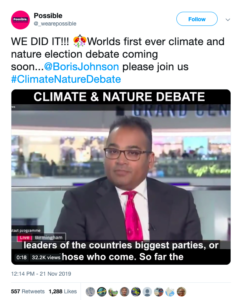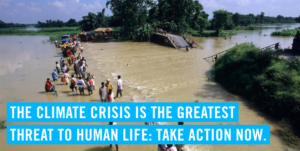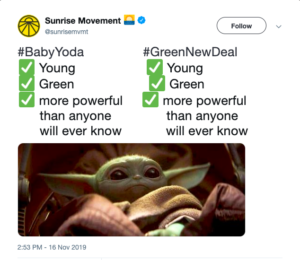‘Climate emergency’ became the official word of 2019, thanks to countless charities, organisations and protest movements raising the alarm in radical ways. So we’re taking a look at some of the biggest lessons from a year of spectacular climate campaigns.
Focus on achievable, tangible wins
Rather than casting the net too wide, many organisations launched highly focused campaigns in 2019 – uniting supporters around significant victories.
Take for example the campaign for a televised climate debate, led by Possible (formerly 10:10) and the UK Student Climate Network, plus a coalition of other orgs including Greenpeace UK.
With a laser focus on just one target and an airtight theory of change, this campaign felt both urgent and winnable. But it also felt monumental. This debate would be a world first, and could set a precedent for future elections around the world. This potent combination generated a huge buzz in both social and mainstream media.
After 200,000 petition signatures and 9,500 emails to broadcasters, Channel 4 hosted an hour long climate debate with almost all political leaders.
What’s the lesson?
Focusing energy on achievable, groundbreaking campaigns like this can keep motivation high and drive momentum for the next big win. Replicate this by rallying your supporters around one small but significant action, supported by a concrete theory of change.

Don’t stay in one lane
Talk of climate change used to be exclusive to environmental and nature charities. But 2019 busted the conversation wide open. Now, we’re more comfortable than ever talking about the crisis in an intersectional way.
It’s promising that organisations like Amnesty International UK are adding to the narrative, joining the dots between environmental issues and human rights.
Through petitions that demand action on ‘the greatest threat to human life’ and powerful storytelling about indigenous and frontline activists, Amnesty helped to make clear that extreme weather events are already disproportionately harming some of the most vulnerable people, and that an environmental issue is inherently a human issue.
What’s the lesson?
The link to your work may not be immediately obvious, but the climate crisis will impact your community or supporters – so don’t be afraid to talk about it. The more lenses we look at the climate crisis through, the more likely we’ll achieve meaningful action.

Make it personal
One major success in 2019 was the shift from a focus on individuals, to the actions of companies and governments. But campaigns that appeal to personal actions and engagement can often be more compelling. So how can campaigners find a balance?
350.org are skilled in making the climate crisis personal and tangible, then directing that energy towards the real culprits. For example, this engagement tool we developed with them allows people to see how CO2 in the atmosphere has increased since the month they were born. After receiving their results, users were directed to sign up to join the climate strikes, plus a series of political actions via email.
Shifting the onus to systems change, rather than lifestyle change, is really powerful. It’s something we hope to see even more of in 2020.
What’s the lesson?
Using a personal hook can engage supporters and place them in the centre of the climate conversation – when often it can seem so complex and daunting. It’s also a great way to mobilise people to take higher bar actions against those responsible.

Use digital tools to build a movement offline
Last year saw a lot of decentralised movements flourishing, thanks in part to social media and other digital tools.
Extinction Rebellion adopts a horizontal structure, allowing people to organise actions at a grassroots level, often using Whatsapp to remain agile. The Sunrise Movement used social media to great effect, with young activists using TikTok, memes and live streams to get their message out to other young people in a way that resonates. And Fridays for Future created an interactive map so young people could plan and host strikes in hundreds of countries.

Digital tools allowed activists to create the largest online and offline climate movements the world has ever seen. Young people really led the way in ‘digital-first’ movement building, something we’re excited to see.
What’s the lesson?
To build a thriving digital movement, it’s important to meet people where they already are. Think about where and how your audience already engages online, and how to reach them in a meaningful way.
What do you want to see more of in climate campaigns for 2020? We’d love to hear your thoughts.

